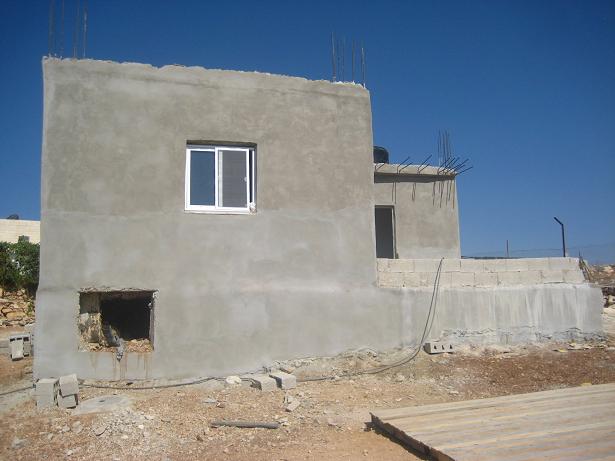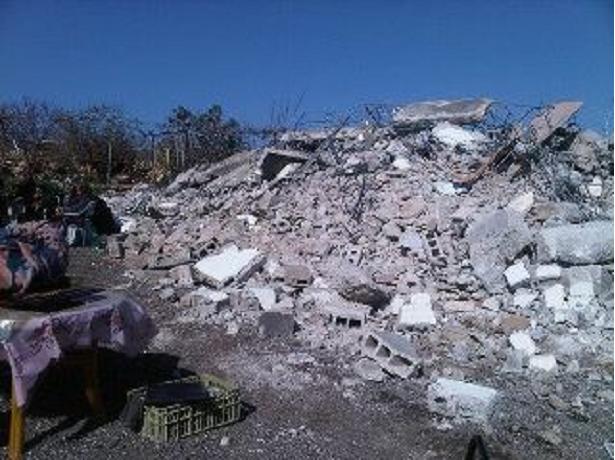Palestinian home demolitions: the ethnic cleansing that dare not speak its name
Livia Bergmeijer
 | ||
The ICAHD activists in front of the completed Abu Omar family home in July 2011 (Photo: Livia Bergmeijer)
The home belonged to the Abu Omars, a large family of fifteen who,
after having had their house demolished in 2005, and after living for
six years in their neighbour’s house, were finally able to move back
into their new house last summer. Today, they are once again homeless,
displaced, distraught, and helpless.January 27, 2012 Livia Bergmeijer reports on the destruction by Israeli bulldozers earlier today of two Palestinian families' homes. This is the latest in a long-running pattern across the occupied territories, whose rate and methods, Bergmeijer argues, betray a policy of gradual ethnic cleansing at work. Last summer, I took part in a rebuilding camp with the Israeli Committee Against House Demolitions(ICAHD). On the 24th July 2011, a group of Palestinians, Israelis and International peace activists finished rebuilding a demolished Palestinian home. Today, exactly six months later, Israeli occupation forces have, once again, demolished it. While on the camp, we were hosted by the Shawamrehs, at their house "Beit Arabiya" ("Arabiya’s house"). Their house too was demolished late last night. The fifth time that Salim and Arabiya’s house has been reduced to rubble. They had dedicated the house as a peace centre in the memories of Rachel Corrie and Nuha Sweidan (two women killed while resisting home demolitions in Gaza) and is used to host the participants of the camp every summer. ICAHD reports that, "Arabiya was there and when she witnessed the demolition she fell to the ground. All their trees and vines were uprooted. There is nothing left." The Abu Omar and Shawamreh families’ land is situated in the Occupied West Bank town of Anata, in what is known as "Area C", meaning it is under complete Israeli military control. Palestinians are almost never granted building permits by the Israeli authorities, and therefore are forced to build or expand their homes "illegally". This is the most common reason given by the Israeli authorities for house demolitions. However, as an occupying force, Israel doesn’t have the legal right to grant nor deny permits as it is not entitled under International Law to conduct civil planning. The Abu Omar family home near completion in July 2011 (Photo: Livia Bergmeijer)No alternative housing or compensation is ever given to Palestinian families whose houses are demolished. Under the Fourth Geneva Convention, Occupying Powers are prohibited from destroying Palestinian property or employing collective punishment. Article 53 reads: "Any destruction by the Occupying Power of real or personal property belonging individually or collectively to private persons…is prohibited." Under this provision the practice of demolishing Palestinian houses is banned, as is the wholesale destruction of Palestinian infrastructure. The ruins of the demolished Abu Omar family home 24th January 2012 – (photo: Itay Epshtain – ICAHD)We must do everything in our power to stand up against this brutal process of ethnic cleansing. The rebuilding of Palestinian homes is not a humanitarian act; it is a non-violent political strategy aimed at resisting the occupation whilst showing solidarity with Palestinians. ICAHD has vowed to continue rebuilding homes in the Occupied Palestinian Territories, and in doing so will not submit to the Israeli occupying forces’ attempts to deter its resistance of the illegal occupation. For Teodora Todorova’s report on house demolitions in Israel click here.
Livia Bergmeijer is an Italian/Dutch writer and activist. She is a member of the Oxford Students' Palestine Society and took part in a rebuilding camp with the Israeli Committee Against House Demolitions (ICAHD) in the summer of 2011.
---------------------------------------------------------------------- New UN Report Shows Sharp Rise In Palestinians Uprooted By Israeli DemolitionsUN News Centre Report
|





No comments:
Post a Comment